Indigo DQM's Data Management Engine (DME) uses the Indigo Scape DRS Data Reporting and Document Generation System to create advanced Data Reports and documents for Data Queries and Data Execution Plans in the Data Asset Store(s). Various other reporting systems are also supported but for the best functionality and compatibility Indigo DRS Reports should always be used.
Indigo Scape DRS is an advanced Data Reporting and Document Generation System using HTML, XML, XQuery, XSLT and Python to generate highly compatible and content rich business reports and documents with standard HTML.
Representing the ultimate in specialist reporting software our advanced technology and reusable reporting platform is a powerhouse in Data Reporting. Indigo DRS is totally unique in its ability to Query in both XQuery and Python and use Data from multiple sources and types simultaneously.
With advanced reporting features, unmatched functionality and effortless integration of this powerful software technology into your business you can be assured of having the best reporting capabilities!
The optional Indigo DRS Report Designer, not included, can quickly create advanced reports rich in content with many options for styling, formatting and customisation. Tables, Charts and Graphs can be added to the report effortlessly allowing complex data to be presented in a visual and meaningful format with the minimum of effort.
Indigo DRS Advanced Features
- Powerful RDL Report Engine
- XQuery / XPath, XSLT, Python, SQL
- Data Visualization, Charting and Graphs
- Data Tables, Data Sheets and Pivot Tables
- Data Mapping, Filtering, Sorting and Statistics
- Data Manipulation, Modelling and Forecasting
- Expression and Formula Evaluation
- Imaging, Drawing, CAD, Barcodes, QR Codes
- Report Rules and Data Contexts
- Artificial Intelligence / Machine Learning*
- Table of Contents and Indexing
- Sub Reports, Modular / Shared Reporting
- Include Data from XML, JSon, CSV, XLSX
- Query and Import Data from API's
- HTML, PDF and Text Document Outputs
- PDF Security, Permissions and Certificates
- Report Templates and Fragment Libraries
- Report Management and Publishing Tools
- Report Packaging and Deployment
- Report Licensing Entitlement*
- Data Security and Encryption
- Password Management Tools
- Reusable Reporting Platform (.NET Library)
Indigo DRS Benefits and Advantages
- Rapid Report Development (RRD)
- Easier Deployment and Installation
- Rapid Deployment of Reports
- Maximised Sharing / Reuse
- Enhanced Functionality
- Greater Report Flexibility
- Reusable Content and Modules
- Improved Report Maintenance
- Reporting Engine Maximises Data Assets
- Lower IT / Support Overhead
- Secure and Encrypt Reports
- Protect Report Intellectual Property and Assets
- Reduced Business and Technology Costs
- Profitability boost with Report Licensing options
Indigo DRS Creates
- Finance Reports
- Crypto Reports
- Technical Reports
- Risk Assessments
- Fund Reporting
- Charts and Graphs
- Statistical Reports
- Engineering Reports
- Scientific & Medical Papers
- Technical Data
- Mathematical Reports
- Financial Statements
- Financial Forecasting
- Suitability Reports
- Regulatory Reports
- Management Reports (MI)
- Invoices / Bills, Quotes
- Geo Data, Locations & Maps
- Administrative Papers
- Legal Documents
- Account Statements
- Insurance Policies
- Certificates / Awards
- CV's / Resumes
- General Documents
- And much more!
With advanced reporting features, unmatched functionality and effortless integration of this powerful software technology into your business you can be assured of having the best reporting capabilities!
Indigo DRS Technology
Indigo Scape Data Reporting System (DRS) comprises of the Report Designer Tools and the separate Report Engine .NET reusable software component library. The Indigo DRS Report Designer creates the reports and the Report Engine renders the reports in HTML and PDF for use in your .NET applications and / or websites.
Report Definition Language (RDL)
The Indigo Scape Data Reporting System (DRS) uses Indigo DRS RDL (Report Definition Language) which is an XML vocabulary using a flexible machine readable Markup Language to define and describe Report structure, elements, functionality, content and Data.
Indigo DRS Report Definition Language represents a standard for creating complex and interchangeable Reports between Indigo DRS systems and also maximises content reuse and modularity.
Report Designer Tools [Optional Extras]*
The Report Designer can quickly create advanced Reports rich in content with many options for styling, formatting and customisation. Tables, charts and graphs can be added to the Report effortlessly allowing complex Data to be presented in a visual and meaningful format with the minimum of effort.
In addition to the Report Designer, Indigo DRS also includes a suite of powerful Report Management Tools and utilities to assist with the design, development and implementation of Reports and the querying of Report Data.
Creating a Report with a Chart
Charts can be added to the Report using the Chart Designer including Bar, Column, Pie, Line and many more...
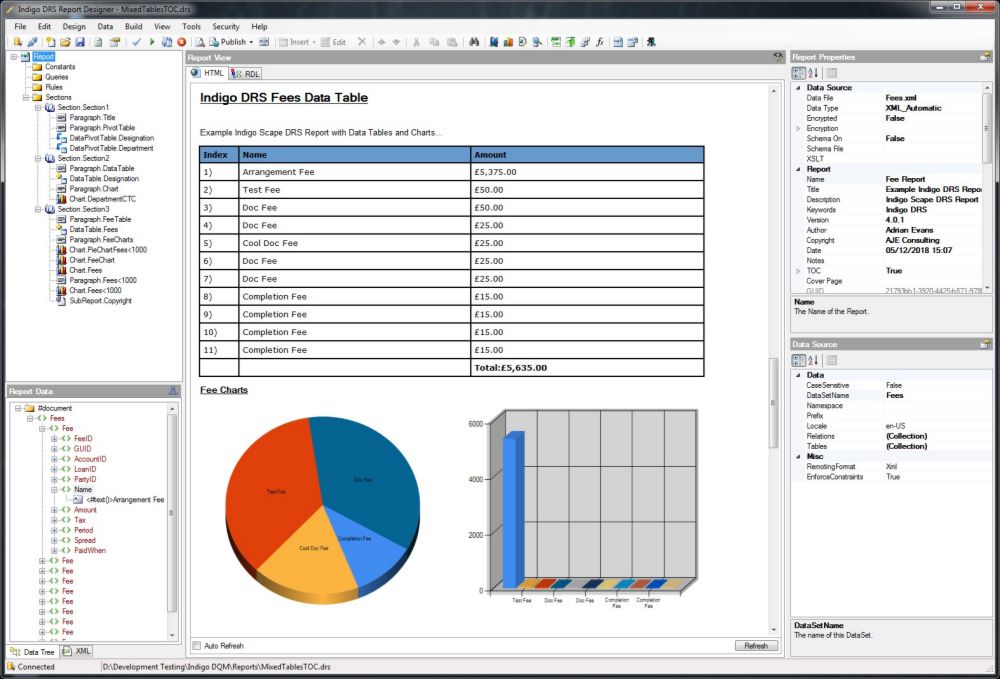
Creating a Report with a Line Chart
Report shows the share prices for IBM and took less than five minutes to create.
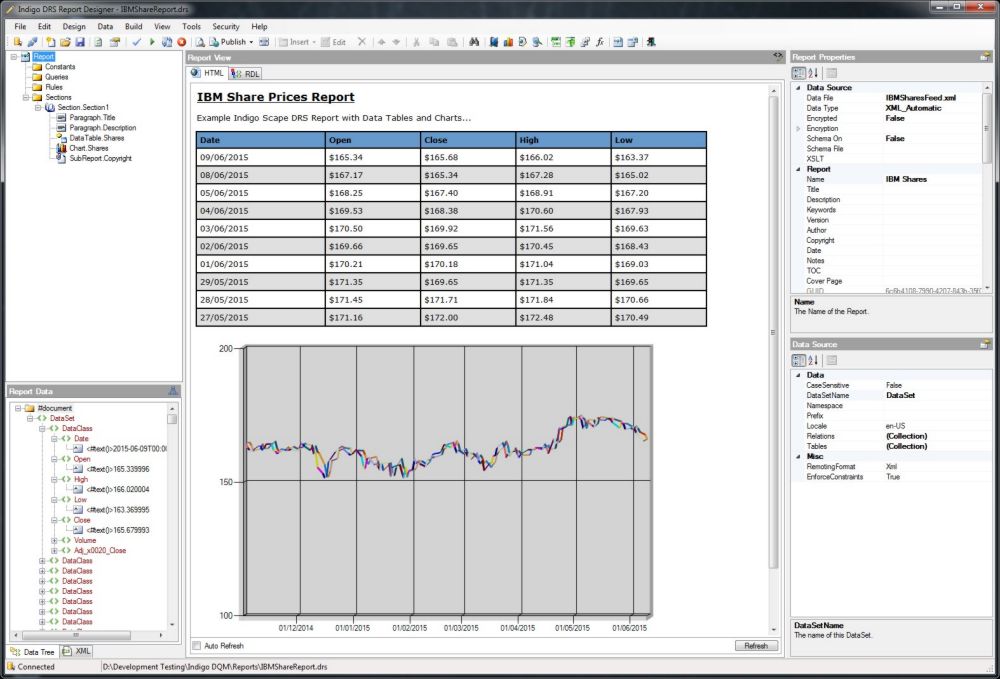
Report appearances and styles can easily be customised with styling and CSS.
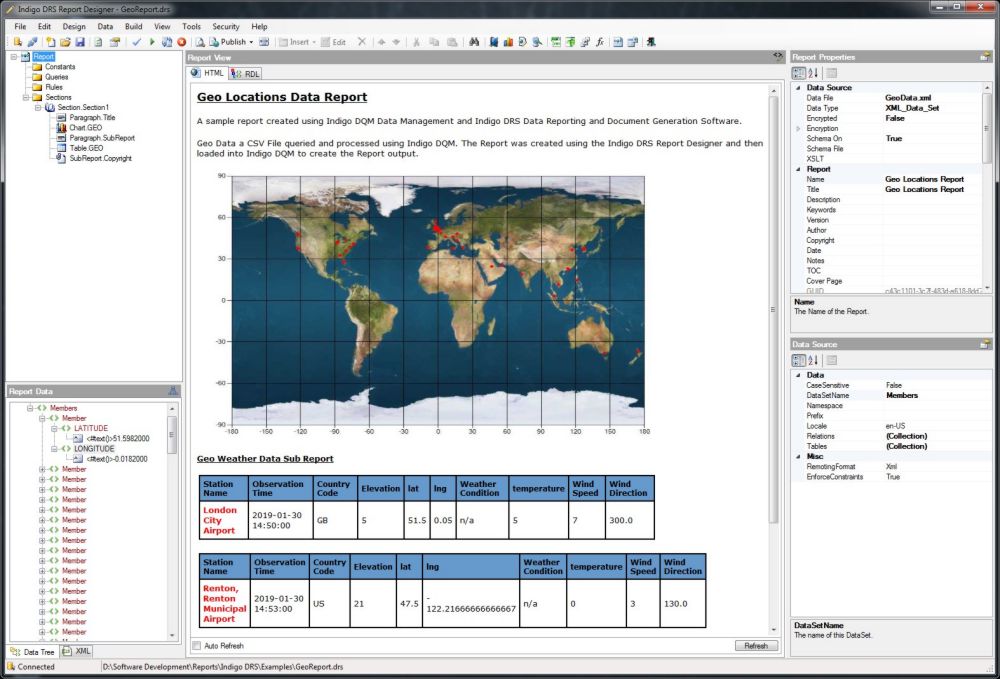
Geo Locations Report using Report Data Context API's for Geo Location Weather Data.
Preview Report to view the HTML Report Output
Report previews can be saved, copied and printed. PDF Files can also be output for the Report build.
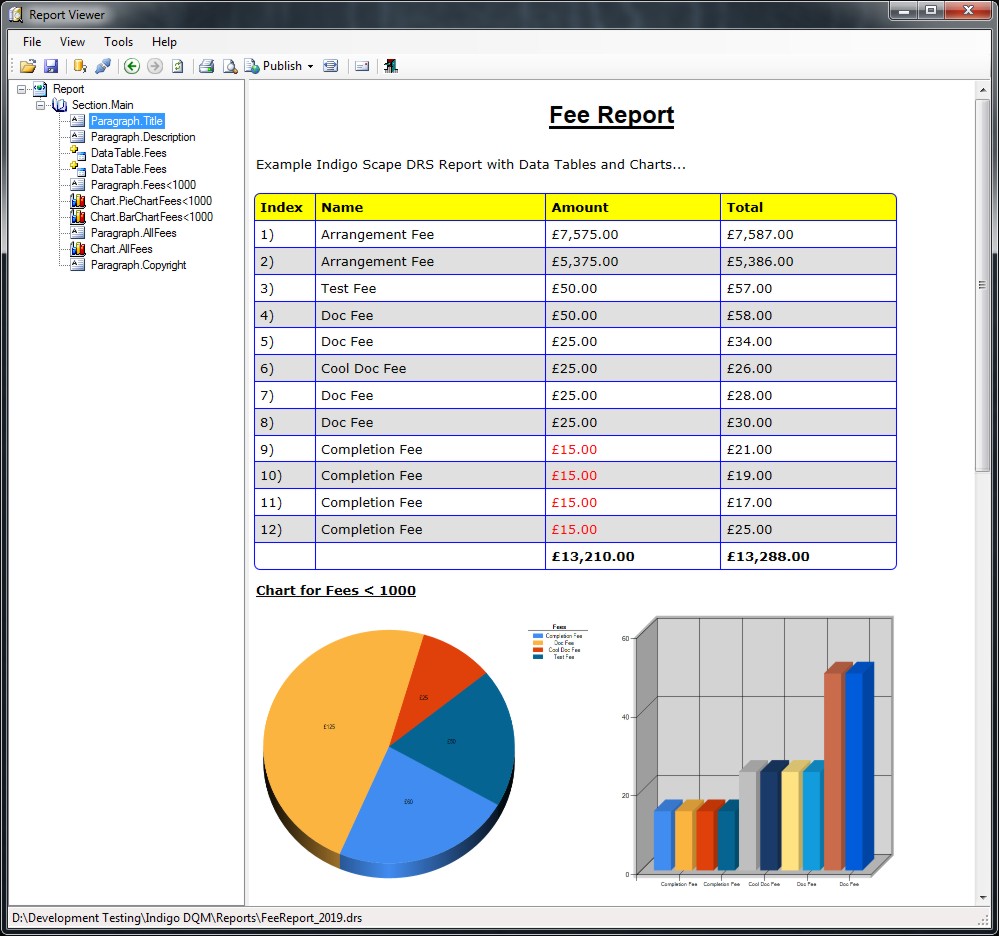
Report PDF Print
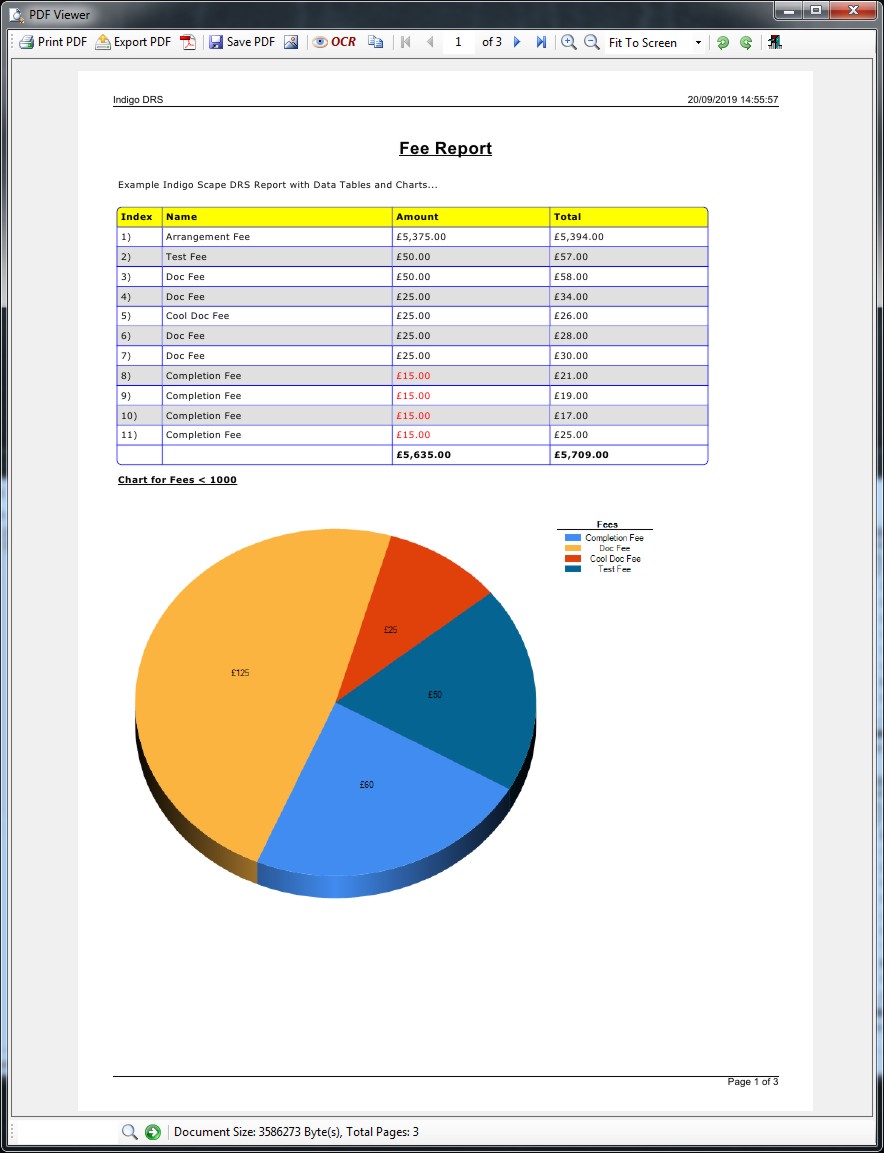
Basic Concepts
HTML (Hyper Text Markup Language) is the standard markup language used to create web content. XQuery is a query and functional programming language that queries and transforms collections of structured and unstructured data, usually in the form of XML Data.
XSLT (Extensible Stylesheet Language Transformations) is a language for transforming XML documents into other XML documents or other formats such as HTML for web pages or plain text.
IronPython can use the .NET Framework and Python libraries, and other .NET languages can use Python code just as easily.
Indigo DRS brings these technologies together to create an advanced reporting and document generation platform that is highly compatible and requires no additional components, software or hardware upgrades.
XQuery
XQuery contains a superset of XPath expression syntax to address specific parts of an XML document. The language is based on the XQuery and XPath Data Model (XDM) which uses a tree-structured model of the information content of an XML document.
XQuery is used to query Report Data adding content to the Report with queries, rules, paragraphs, charts and tables. Fully modular design allows common sections of the Report to be included as Sub Reports. Report Rules can also be applied to manage how Report content is displayed.
XSL Transformations
XSLT (Extensible Stylesheet Language Transformations) is a language for transforming XML documents into other XML documents or other formats such as HTML for web pages or plain text.
Indigo DRS implements XSLT and is designed for use as part of XSL, which is a stylesheet language for XML. In addition to XSLT, XSL includes an XML vocabulary for specifying formatting. XSL specifies the styling of an XML document by using XSLT to describe how the document is transformed into another XML document that uses the formatting vocabulary.
Python Scripting
In addition to XQuery the Data Report Engine can use IronPython an open-source implementation of the Python programming language which is tightly integrated with the .NET Framework. IronPython can use the .NET Framework and Python libraries, and other .NET languages can use Python code just as easily. Python scripting can be used to query Report Data and create Report Data Contexts and Report Rules.
SQL Queries
Using IronPython and the System Data namespace Indigo DRS can run Structured Query Language (SQL) statements to create, maintain and retrieve Data from a relational Database. SQL queries can also be used to create Report Data Contexts and Report Rules.
Data Mapping, Filtering and Sorting
Data Filtering is the process of choosing a smaller part of a Data Set and using that subset for viewing or analysis. Data Sorting is the process that involves rearranging the Data into some meaningful order to make it easier to understand, analyze or visualize.
Report Data Filters can be applied to Report Data Tables and Report Charts allowing Data to be filtered and sorted by Data Columns using rules to filter and sort as required. Data Source Mapping can be used to map data and add additional custom Data Columns to a Data Table using formulas, expressions and queries.
Expression Evaluation
The Report Engine can evaluate complex mathematical equations and formulas allowing scientific, engineering, finance and mathematical expressions to be calculated. Report Designer Tools features an Expression Editor which includes common functions, constants and scientific units allowing formulas and equations to be evaluated and used in the Report.
Report Data Contexts
Report Data Contexts are used to drive and build report output content and allows the consolidation and integration of data from multiple different sources and types such as API's, websites, databases and data files.
Data Contexts can be applied to specific Report elements or be shared named Data Contexts reusable throughout the Report.
Context types can be XQuery, Python, XML, CSV, JSon, XLSX, HTML, MS SQL, MDB, ODBC and OLEDB Data Sources that can be read and used in the report.
Report Rules
Report Rules are conditional XQuery or Python expressions that determine if Report content is enabled and displayed in the output build. Rule based queries return True or False and can query the Report Data Source and other Report Data Contexts. Report Rules are useful for controlling the flow and visibility of Report content.
For example, certain sections of a common Report may only be relevant for a particular type of product or customer. Report Rules allow content to be controlled by switching it on or off depending on certain conditions in the Report Data.
Report Sub Reporting
Report Sub Reporting makes it possible for a Report to contain other Reports in subsections of the main Report. These Reports are called Sub Reports and allow Report content to be modularised and shared between Reports and even other Sub Reports. Sub Reports can be used if Report content is duplicated, reusable or common to other Reports. Sub Reporting improves Report performance, maintenance, development and deployment.
Report Table of Contents
Report Table of Contents is used to navigate Report content and can be included in Report output builds. The Table of Contents (TOC) are automatically generated from the Report structure and elements with options for styling and indexing.
Report CSS
Cascading Style Sheets (CSS) is a style sheet language used for describing the look and formatting of a document written in a markup language such as HTML. CSS is designed primarily to enable the separation of document content from document presentation, including elements such as the layout, colors, and fonts.
Indigo DRS uses CSS style sheets extensively improving content accessibility, providing more flexibility and control in the specification of presentation characteristics, enabling multiple HTML pages to share formatting by specifying the relevant CSS in a separate CSS File, and reduce complexity and repetition in the structural content.
PDF Security, Encryption, Permissions and Certificates
Indigo's powerful Report Engine can output documents in PDF
format with advanced security options to protect intellectual
property by password protecting and encrypting documents.
Report content can also be restricted with permissions and certificates can be added to the digital file to ensure content is not tampered or interfered with. This is ideal for sensitive or important legal documents which need to be protected from interference.
Report Templates and Fragment Libraries
Report Template Management helps build new Reports from pre-existing designs and layouts enabling the rapid design, development and publishing of Report content. Report Fragment Libraries help build new Reports from pre-existing designs and layouts in the form of Report Fragments.
Report Management and Publishing Tools
Report Management and Publishing Tools enables the publishing of Report content to multiple locations in one operation.
Report Licensing Entitlement*
Report Licensing Entitlement (RLE) allows the use and distribution of Reports to be governed and controlled with a powerful licensing system. Flexible licensing terms allow Reports to be distributed with conditions tied to hardware, users and infrastructure thus maximising control, distribution and profitability.
Report Licensing is an optional feature that requires a separate application licensing entitlement to be purchased for the Report Designer Tools!
Reusable Reporting Platform
Data Report Engine .NET Component SDK is a reusable software reporting platform that renders and outputs Reports created by the separate Indigo DRS Report Designer. The Report Engine component library can be used to generate and output Reports for applications and / or websites in the .NET framework using Indigo DRS RDL (Report Definition Language).
Compatibility
Indigo DRS is compatible with Data on most operating systems such as Windows, Linux, Unix, Mac OS etc. using ODBC, XML, JSon, CSV, XLSX or HTML. The Reports generated by Indigo DRS give the best functionality and compatibility and because they use standard HTML for reporting the documents can be displayed on any type of device whether a PC, tablet, mobile and in any type of browser.
*NOTE: Indigo DQM is compatible with the Indigo DRS Data Reporting and Document Generation System. However, Indigo DQM does not include the Indigo DRS Report Designer Tools or the reusable Report Engine SDK software component library these are optional extras that require licensing separately!

